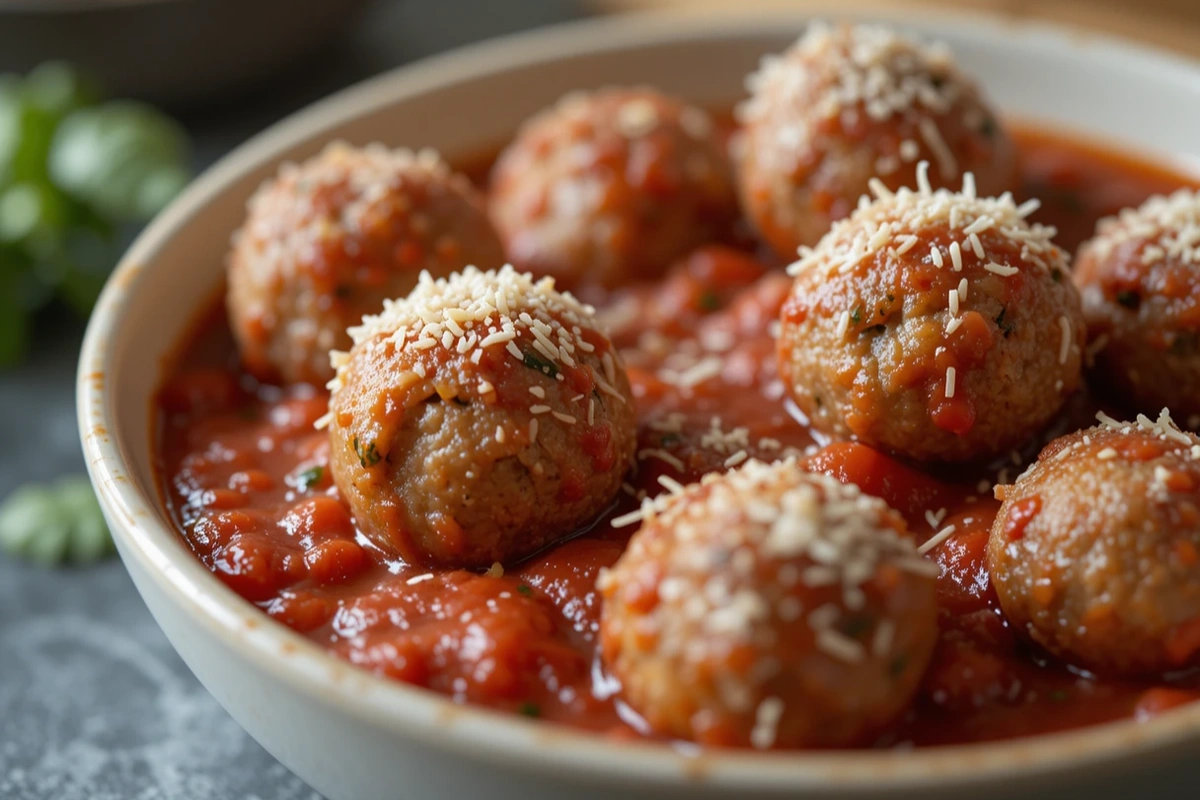Frozen meatballs are a game-changer for busy home cooks. They’re convenient, versatile, and packed with possibilities for creating delicious meals without the hassle of starting from scratch. Whether you’re whipping up a quick weeknight dinner, preparing a party appetizer, or looking for ways to incorporate protein into your diet, frozen meatballs can do it all.
This guide dives deep into everything you need to know about frozen meatballs: their types, nutritional value, cooking methods, recipes, and storage tips. By the end, you’ll have all the know-how to make the most of this kitchen staple while keeping your meals exciting and healthy.
Introduction to Frozen Meatballs
What Are Frozen Meatballs?
Frozen meatballs are pre-made, ready-to-cook or fully cooked meatballs stored at sub-zero temperatures to maintain their freshness and longevity. These meatballs come in a variety of flavors, ingredients, and protein sources, catering to diverse dietary preferences.
You can find them in the frozen aisle of grocery stores, neatly packaged and ready to use. Their versatility means they can be used in countless dishes, from Italian classics like spaghetti and meatballs to hearty casseroles and crowd-pleasing appetizers.
Why Are Frozen Meatballs Popular?
It’s no surprise that frozen meatballs have become a kitchen essential. They save time, reduce preparation work, and offer consistent flavor and texture. For busy families, they’re a lifesaver on hectic weeknights when whipping up a meal in under 30 minutes is a priority.
Plus, frozen meatballs are often cost-effective, making them a budget-friendly protein option. Their long shelf life also makes them a convenient backup for when fresh ingredients run out.
The Versatility of Frozen Meatballs in Cooking
One of the best things about frozen meatballs is their adaptability. They seamlessly blend into a variety of cuisines—Italian, Swedish, Asian-inspired dishes, and more. Whether you’re simmering them in marinara sauce, glazing them in a sticky teriyaki sauce, or serving them as appetizers, the possibilities are endless.
By keeping frozen meatballs on hand, you’re never far from a delicious and satisfying meal.
How Frozen Meatballs Are Made
Ingredients Commonly Used in Frozen Meatballs
Frozen meatballs typically contain a mix of ground meats such as beef, pork, chicken, or turkey, blended with breadcrumbs, eggs, and seasonings. Many manufacturers add herbs and spices like garlic, parsley, and paprika to enhance flavor. Some frozen meatballs also include fillers like soy protein or textured vegetable protein to improve texture or reduce costs.
Premium options often focus on using higher-quality meat with fewer preservatives or additives. These versions cater to health-conscious consumers seeking cleaner ingredient profiles.
Processing Techniques: From Fresh to Frozen
The journey of frozen meatballs begins with forming the mixture into uniform spheres using automated equipment. The meatballs are then either pre-cooked (through baking or steaming) or left raw, depending on the product.
Next, they undergo flash freezing, a method that preserves the meatballs’ texture, flavor, and nutritional value by rapidly lowering their temperature. This ensures they stay fresh during storage and transport.
Finally, frozen meatballs are packaged in air-tight bags or containers to protect them from freezer burn and contamination. Proper sealing and labeling are essential for maintaining quality and shelf life.
Types of Frozen Meatballs Available in Stores
Beef, Chicken, Turkey, and Plant-Based Varieties
Frozen meatballs come in a wide range of protein sources to suit different tastes and dietary needs. Beef meatballs are a classic choice, known for their rich flavor and tender texture. Chicken and turkey meatballs offer leaner alternatives, ideal for those seeking lower-fat options.
For vegetarians and vegans, plant-based meatballs made from lentils, chickpeas, or soy protein are gaining popularity. These options are not only environmentally friendly but also high in fiber and nutrients.
Pre-Cooked vs. Raw Frozen Meatballs
When browsing the frozen aisle, you’ll notice both pre-cooked and raw frozen meatballs. Pre-cooked varieties save time, as they only require reheating. They’re perfect for quick meals or snacks.
Raw meatballs, on the other hand, allow for more customization. You can cook them from scratch, adding your own sauces and seasonings to match specific recipes. These often take longer to prepare but offer greater flexibility in flavoring.
Seasoned vs. Plain Meatballs
Some frozen meatballs are pre-seasoned with flavors like Italian herbs, BBQ spices, or teriyaki glaze, making them convenient for specific cuisines. Others are plain, allowing you to season them as you like. Both options cater to diverse culinary needs, so you can always find something that fits your cooking style.
Nutritional Value of Frozen Meatballs
Nutritional Content of Frozen Meatballs (Per 100g)
Frozen meatballs provide a rich source of protein and essential nutrients. However, their exact nutritional values depend on the brand and recipe. Here’s a general breakdown:
| Nutrient | Amount (Per 100g) | Health Benefits |
|---|---|---|
| Calories | 200–250 kcal | Provides energy for daily activities. |
| Protein | 10–15 g | Supports muscle growth and tissue repair. |
| Total Fat | 10–18 g | Promotes satiety and contains healthy fats. |
| Saturated Fat | 3–6 g | Should be consumed in moderation. |
| Sodium | 400–600 mg | Helps balance fluids but may be high in some brands. |
| Carbohydrates | 5–10 g | Offers a quick energy source. |
| Fiber | 1–2 g | Aids digestion and supports gut health. |
Calories, Protein, and Fat Content
Frozen meatballs are a convenient source of protein, but their nutritional value can vary widely depending on ingredients and preparation. On average, a serving of frozen meatballs (about 100g) contains:
- Calories: 200–250 kcal
- Protein: 10–15g
- Total Fat: 10–18g (including 3–6g saturated fat)
These figures make frozen meatballs a good choice for those seeking a protein-packed meal, though the fat content may be higher in certain varieties. Opt for leaner options like turkey or chicken meatballs to reduce calorie and fat intake.
How Frozen Meatballs Fit into a Balanced Diet
Frozen meatballs can be part of a healthy diet when consumed mindfully. Pair them with whole-grain pasta, zoodles, or a side of steamed vegetables for a balanced plate. Their high protein content helps keep you full and supports muscle repair, making them ideal for active individuals.
However, be cautious with sodium levels, as some store-bought versions may contain over 500mg per serving. Checking labels for low-sodium or preservative-free options is a smart move.
Low-Calorie and Keto-Friendly Options
For those following specific diets, like keto or low-calorie plans, there are suitable frozen meatball choices. Many brands now offer gluten-free, low-carb, or plant-based varieties to cater to these needs. These can be paired with keto-friendly sauces or served over cauliflower rice for a wholesome, diet-compliant meal.
For more delicious protein-packed ideas, explore Yumy Bite Recipes.
How to Cook Frozen Meatballs
Cooking Methods: Stovetop, Oven, and Air Fryer
Frozen meatballs are incredibly versatile and can be cooked in various ways:
- Stovetop: Heat frozen meatballs in a pan with your favorite sauce. Simmer on low for 15–20 minutes until thoroughly heated.
- Oven: Preheat to 375°F, place the meatballs on a baking sheet, and cook for 20–25 minutes. This method is great for achieving a crispy exterior.
- Air Fryer: Arrange meatballs in a single layer in the air fryer basket. Cook at 375°F for 10–12 minutes, shaking halfway through for even cooking.
Quick and Easy Meal Ideas Using Frozen Meatballs
Frozen meatballs are a lifesaver when you need a quick meal. Try these ideas:
- Classic Spaghetti and Meatballs: Toss cooked meatballs with marinara sauce and serve over pasta.
- Swedish Meatballs: Simmer in a creamy sauce and serve with mashed potatoes or noodles.
- Meatball Subs: Load toasted rolls with meatballs, marinara, and melted mozzarella for a hearty sandwich.
Tips for Preventing Dry or Overcooked Meatballs
To keep frozen meatballs juicy and flavorful:
- Use a thermometer to check the internal temperature (165°F for fully cooked meatballs).
- Add them to a sauce during cooking to lock in moisture.
- Avoid overcrowding when baking or air frying for even heat distribution.
For more cooking inspiration, check out the Hot Honey Chicken Recipe for a unique twist on comfort food.
Frozen Meatball Recipes for Every Occasion
Classic Spaghetti and Meatballs

One of the most popular ways to enjoy frozen meatballs is in the timeless dish of spaghetti and meatballs. This Italian-American classic combines al dente pasta with savory marinara sauce and tender meatballs for a satisfying meal.
To make it extra special, simmer the frozen meatballs in the sauce for 20 minutes, allowing the flavors to meld. Garnish with freshly grated Parmesan and basil for a restaurant-quality dinner at home.
Meatball Sub Sandwiches
Frozen meatballs shine in hearty meatball subs. Toast hoagie rolls, layer them with marinara sauce, melted mozzarella, and cooked meatballs, and you’ve got a crowd-pleaser.
For an elevated touch, add sautéed onions and peppers or sprinkle with red chili flakes for a hint of spice. These subs are perfect for game days or casual gatherings.
Swedish Meatballs with Cream Sauce

Transform frozen meatballs into a comforting dish with creamy Swedish-style gravy. The sauce, made from beef broth, heavy cream, and a dash of Worcestershire sauce, pairs beautifully with meatballs.
Serve them over mashed potatoes or buttered noodles, and don’t forget a dollop of lingonberry jam for that authentic Nordic flavor.
Meatball Appetizers: Perfect for Parties
Frozen meatballs are a fantastic option for party appetizers. Try these easy ideas:
- BBQ Meatballs: Toss them in a sweet and tangy BBQ sauce and keep them warm in a slow cooker.
- Teriyaki Meatballs: Glaze with teriyaki sauce and serve with toothpicks for easy snacking.
- Honey Garlic Meatballs: Coat in a sticky honey garlic glaze for a flavor-packed bite.
These appetizers are simple to prepare and guaranteed to impress your guests.
Proper Storage and Shelf Life of Frozen Meatballs
How Long Can You Store Frozen Meatballs?
Frozen meatballs have a long shelf life when stored correctly. Most store-bought varieties can last up to 6 months in the freezer, while homemade versions typically stay fresh for 3–4 months.
To ensure the best quality, store them in an air-tight container or vacuum-sealed bag to prevent freezer burn. Labeling packages with the date of freezing helps you keep track of storage time.
Freezing Tips to Maintain Freshness
Proper freezing techniques can make all the difference in preserving the texture and flavor of your frozen meatballs. When freezing homemade meatballs, arrange them on a baking sheet in a single layer and freeze until firm. Then transfer them to a sealed container or bag.
For pre-cooked meatballs, allow them to cool completely before freezing to avoid condensation, which can lead to ice crystals.
Signs Frozen Meatballs Have Gone Bad
It’s essential to recognize when frozen meatballs are no longer safe to eat. Signs to watch for include:
- Freezer burn: White or grayish spots on the surface.
- Off smells: An unusual or rancid odor after defrosting.
- Texture changes: Meatballs that feel slimy or mushy.
When in doubt, it’s best to discard questionable meatballs to avoid foodborne illness.
Pros and Cons of Using Frozen Meatballs
Benefits of Convenience and Long Shelf Life
One of the biggest perks of using frozen meatballs is their convenience. They’re ready to cook straight out of the freezer, saving you the hassle of mixing, rolling, and cooking from scratch. This makes them ideal for busy weeknights, last-minute meals, or unexpected guests.
Frozen meatballs also have an impressive shelf life. When stored correctly, they remain fresh for months, making them a reliable backup when your fridge is empty. Plus, they come in a variety of flavors and dietary options, so there’s something for everyone.
Drawbacks: Sodium Content and Additives
Despite their many benefits, frozen meatballs have some drawbacks. Many store-bought versions contain high levels of sodium and preservatives to enhance flavor and shelf life. Consuming these in large quantities could contribute to health issues like high blood pressure.
Texture can also be a concern. Some frozen meatballs may feel denser or less tender compared to freshly made ones. Additionally, certain brands include fillers or artificial ingredients, which might not appeal to those seeking a cleaner label.
To minimize these downsides, opt for high-quality brands or make homemade meatballs and freeze them yourself.
FAQs About Frozen Meatballs
Can You Refreeze Thawed Meatballs?
While it’s technically possible to refreeze thawed frozen meatballs, it’s not recommended. Refreezing can compromise their texture and flavor. For best results, only thaw the amount you plan to use, and store any leftovers in the refrigerator for up to three days.
Are Frozen Meatballs Healthier Than Homemade?
The answer depends on the brand and recipe. Some frozen meatballs are made with high-quality ingredients and minimal additives, making them a nutritious choice. However, homemade meatballs allow you to control what goes in, ensuring fewer preservatives and lower sodium content.
How Do You Choose the Best Frozen Meatballs?
When shopping for frozen meatballs, look for options with:
- A short ingredient list featuring whole foods.
- Minimal sodium and added sugars.
- A protein source that aligns with your dietary preferences, such as lean meats or plant-based alternatives.
If you’re interested in more tips about healthy meals, explore Yumy Bite Recipes for inspiration!
Conclusion
Frozen meatballs are a convenient and versatile option for creating delicious, protein-rich meals. With a wide range of flavors and dietary options available, they fit easily into busy lifestyles and diverse cuisines. By choosing high-quality brands, cooking them thoughtfully, and pairing them with nutritious sides, you can enjoy frozen meatballs as part of a balanced diet. Whether it’s a quick dinner or a party appetizer, frozen meatballs are a reliable choice for any occasion!

